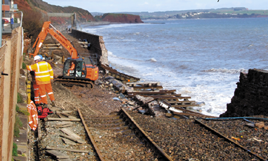“Looking to the future, the key thing for me is that you have to provide a good rail link between Exeter and Newton Abbot/Torbay and Totnes, and provide the towns of Dawlish and Teignmouth with a rail service, too.
“As well as considering possible alternative rail routes, there also needs to be a look at what might be possible in the sea, to protect the coastline itself. Local MP Anne Marie Morris is calling for a breakwater.”
Responding to RAIL’s suggestion that the line via Dawlish is simply too important to be cut off, because of the communities it serves, Burningham says: “You are entirely right about the Sea Wall route providing a vital link to communities. Away from the area, this is often overlooked.
“Regarding alternatives, it strikes me that the Okehampton route could be re-opened quite quickly and at not huge expense if the will was there.
But, while restoring the railway to Okehampton and Tavistock, it would only act as a diversionary route when the Sea Wall route was unusable. There is some fear in South Devon that it would replace the existing railway, and this would not be the case at all.
“Re-opening the Okehampton route would ensure that Plymouth and Cornwall, barring some very freak weather, would always be connected by rail to the rest of the country.
“With the long-standing and well advanced plans to re-open the Bere Alston-Tavistock line, with Coleford Junction to Meldon Quarry still intact, and the Granite Way cycle way uniting ownership of 11 miles of the trackbed from Meldon to Lydford, there’s probably only a gap of around five miles where the trackbed is still in multiple ownership with some building on it.
“There are (as far as I am aware) just two missing bridges on the whole Meldon-Bere Alston section. Meldon Viaduct itself was refurbished in the mid 1990s, and prior to that had been used by lorries and a rail headshunt until (I believe) 1990.”
The importance of the railway was highlighted in a letter sent to Prime Minister David Cameron on February 7, signed by Tudor Evans (Plymouth City Council), John Hart (Devon County Council) and Steve Hindley (Chairman of Heart SW Local Enterprise Partnership).
The letter called for the work to repair the existing line to be undertaken “as a matter of urgency”, and for “an immediate release of the £31.3 million investment programme to support the ten-point programme submitted by Network Rail to help the rail system withstand more frequent flooding”.
It added: “We also need:
A fully funded investment scheme to ensure there is resilience across the South West rail network, and travel times are significantly enhanced
Co-ordinated capital investment from both Network Rail and the Environment Agency to work more closely together.
To connect Plymouth to the Strategic National Corridor network. It sends a clear message from Government to the private sector that they expect business growth, and is vital for business confidence. It costs the Government nothing, but will have a huge benefit for the city.”
The letter concluded: “The rail infrastructure in the South West has suffered from underinvestment for many years, and the entire region is now paying a very high price for this. We want to work with the Government to find practical and urgent solutions.
“Unless these fundamental issues are addressed now, the cost to the Government as a whole through a severely damaged regional economy will be massive.”
The cost to the region of the line being cut in two has varied by as much as £20m per day. If working only on weekdays, this means that by the time this edition of RAIL hits the shelves on March 5, the region will have lost £300m.
That is three times the predicted cost of re-opening the former Exeter-Plymouth via Tavistock line, according to a report written by the West Devon County Committee on November 19 2010 and delivered to the Executive Director of Environment, Economy and Culture.
The report stated: “The potential vulnerability of the railway between Exeter and Teignmouth, and more particularly the 4.2 miles between Dawlish and Teignmouth, became apparent soon after the opening of the railway, in 1846, when a storm destroyed part of the Sea Wall and led to temporary closure of the railway.
“Further cliff falls and sea damage were experienced in the 1850s and 1860s, and were followed by more serious breaches in 1916, and in the 1920s and 1930s. At that stage there was active consideration of an inland diversion around the rear of Dawlish. Further problems were experienced in 1986, and the 1990s.
“Furthermore, in the early years of the last decade, there were a number of occasions when adverse weather resulted in major disruption to train services. This was partly due to the susceptibility of the Voyager trains to spray, when the waves were so fierce that they broke over the roof of the train (where electrical equipment is sited).
“Particularly adverse weather conditions tend to occur on a 20-year cycle, caused by a combination of low pressure, high spring tides and southeasterly gales. Track circuits can get shorted and cables damaged, disrupting train detection and signalling systems. Breaches of the Sea Wall can also result in a washing away of ballast, resulting in its temporary closure.”
The report concluded: “Network Rail is confident that the railway sea defences around Dawlish will not fail in the foreseeable future. The costs of maintaining the sea walls and the estuary are approximately £500,000 a year. Network Rail considers that this regime of continuing maintenance, monitoring and route management will continue to be adequate until about 2025, after which an increased level of funding is likely to be required to maintain rail services along this route all day every day.”
The West Devon County Committee report discussed alternative routes, stating: “The impact of re-routing the Great Western Main Line on settlements within Devon needs to be considered.
“There would be disbenefits to Newton Abbot (removing its direct connectivity to London), and potentially Torbay, Totnes and Ivybridge - not to mention the other settlements such as Dawlish, Dawlish Warren, Starcross and Teignmouth, which would be cut off from the main line.
“There would still need to be a local service from Plymouth (serving Newton Abbot, Totnes, Ivybridge and Torbay).
“Re-routing the main rail line away from these settlements would be an unpopular proposal, and therefore serious consideration over the merits of its implementation would be required. Indeed, it is likely to be unacceptable.
“This position is the same as the UK government, as discussed in Parliament on November 10 2010 when the Transport Minister stated that this alignment will remain as the main line to Cornwall for the indefinite future. As such, it is important to note that the construction of an inland route, linking Exeter to Plymouth via Okehampton and Tavistock on the previous rail alignment, should not be viewed as an alternative to the existing Great Western Main Line route.
“Having said this, the reinstatement of this route would be welcome, and may indeed be considered in the very long term. However, there are some significant factors which affect the deliverability of this scheme.”
The report continued: “The section of track between Okehampton and Exeter also still remains, but has been reduced to single track and is operated by a private rail company. Furthermore, the alignment of the route between Okehampton and Tavistock has been utilised for other purposes. Areas of land with previous track alignments have been sold off, with the development of West Devon Borough Council offices, other property, and National Cycle Network (NCN) routes.
“In the 1890s there was a double express track. Reinstating this to modern standards is likely to be extremely expensive, and may require greater land take than the original alignment to meet modern railway standards. Other issues include the need to improve the track to overcome potential weight issues on the Meldon viaduct, which is a Scheduled Monument.
“As such, the costs are likely to be extremely prohibitive. There are further issues/constraints at Shillamill Viaduct and Tunnel.
“Further to the engineering requirements, there are also private land ownership issues, such as those in Tavistock where the West Devon Borough Council offices have been constructed.
“A House of Commons enquiry reported in February 2009 that the likely cost of reinstating this railway would be some £100m. Considering that the Government is committed to preserving the current alignment of the Great Western Main Line, it is extremely unlikely that such funding will come forward for this project in the near future.
“Having said this, and as stated above, the reinstatement of this route should not be prohibited by further development of the previous route for other uses. The NCN already acts to informally safeguard the route, and it is the county council’s intention that no further development (such as, of property) occurs on it.
“While the re-instatement of the full alignment between Exeter and Plymouth via Okehampton and Tavistock is unlikely to occur in the short term, it is also important to recognise ongoing developments that seek to introduce local services along some parts of this route.”
The report concluded: “The impact of re-routing the railway would have significant, and potentially unacceptable, implications for settlements located on it. As such, the Government has clarified that this will remain the alignment of the main line into Cornwall for the indefinite future.
“Having said this, the reinstatement of the former Southern Region rail route would still be welcome if it could be delivered. However, unfortunately, due to engineering and historic constraints, the cost of this is considered to be prohibitive. While this is the case for the foreseeable future, it is still intended to safeguard the route should circumstances change.
“In the meantime, local rail enhancements between Okehampton and Exeter and between Tavistock and Plymouth are being pursued at present. These will provide significant local benefit, and would not prevent the reinstatement of the longer route if this were eventually progressed.”
Transport Secretary Patrick McLoughlin did announce just after the wall was demolished at Dawlish that alternatives would be looked at. Business leaders have called for it, but so far there has been silence.
This article can be read in RAIL 743
















Login to comment
Comments
Philip Walker - 11/09/2017 16:18
The solution to the Dawlish problem (and due to climate change, it is likely to remain a problem however much Network Rail strengthens the Sea Wall etc) must be a permanent new main line inland between Exeter and Newton Abbot - as was proposed before the Second World War. This would obviously be better than diversions via a re-opened Okehampton line which would be considerably slower bearing in mind reversals would be needed both at Exeter and Plymouth - the latter involving a considerable retracing a route west of Plymouth for Penzance trains. A new Exeter-Newton Abbot route would mean main line trains would keep running when there're problems at Dawlish, not even needing diversions! And it would enable Torbay to stay connected. It would also make a small contribution to the urgent need for substantial journey time reductions to Plymouth and Cornwall. The Sea Wall line would have to be retained for local traffic and would still have a role in providing extra capacity between Exeter and Newton Abbot. (Costs of such a line shouldn't be any problem, bearing in mind all the money spent on improving trunk roads in the region...)